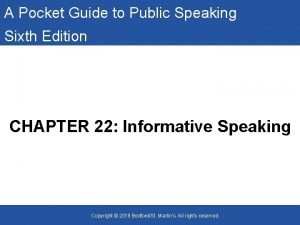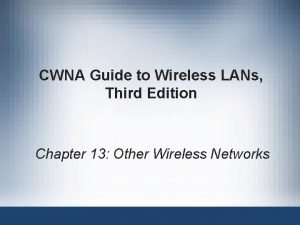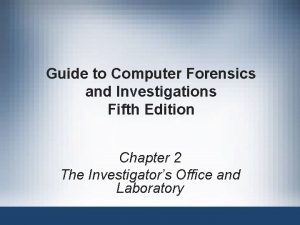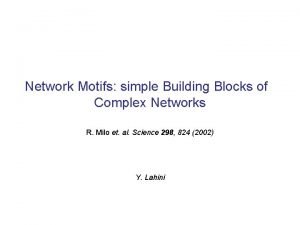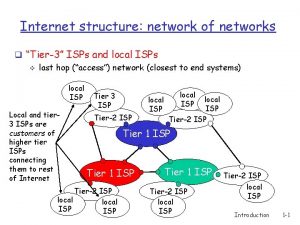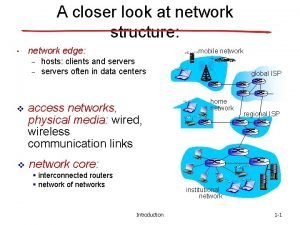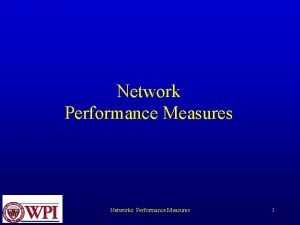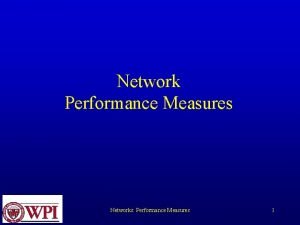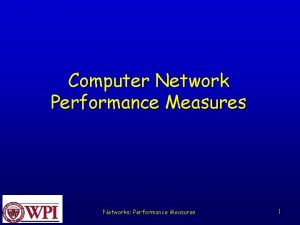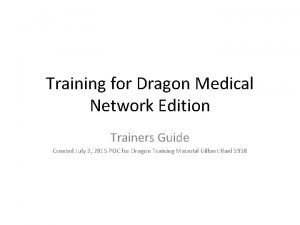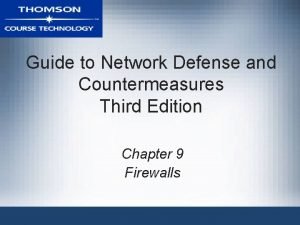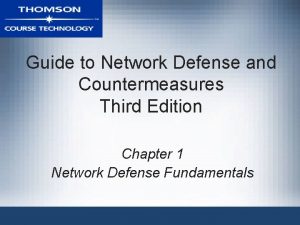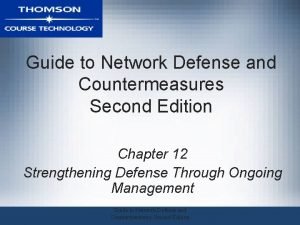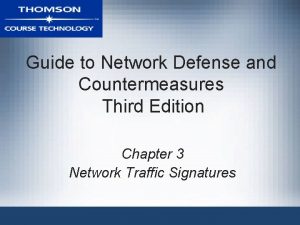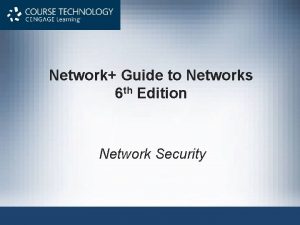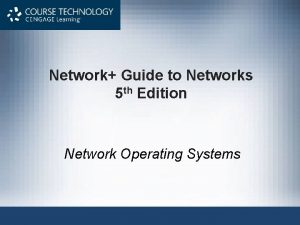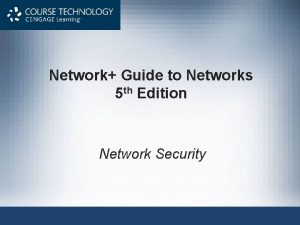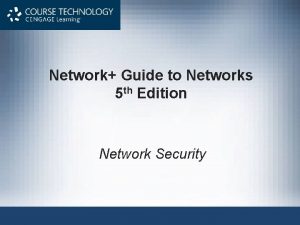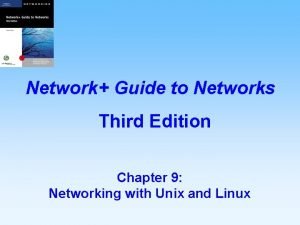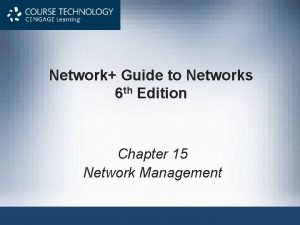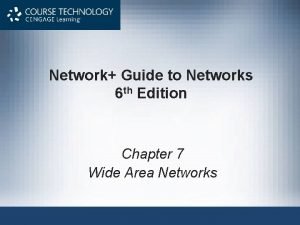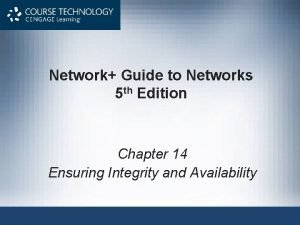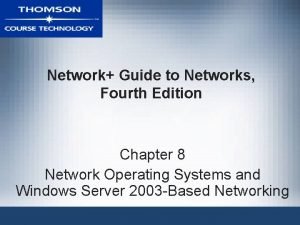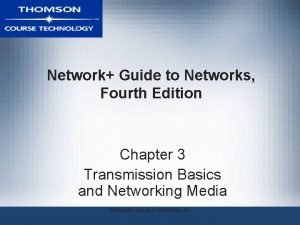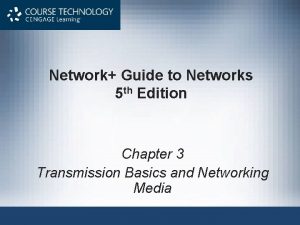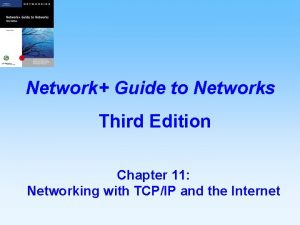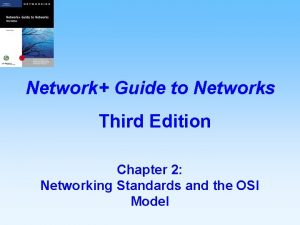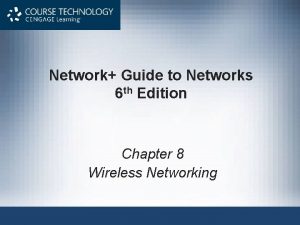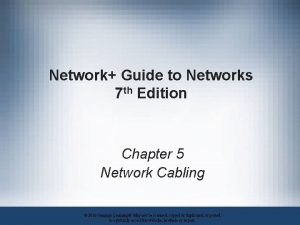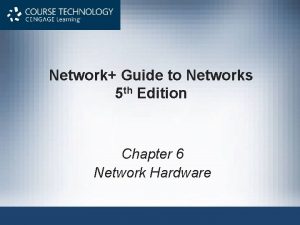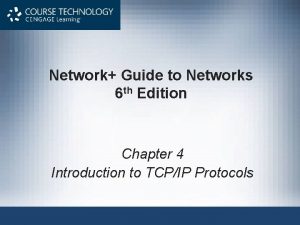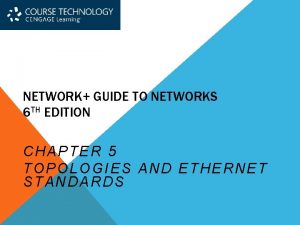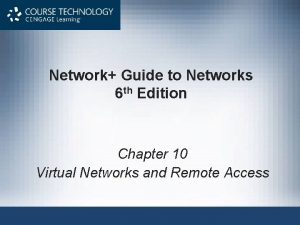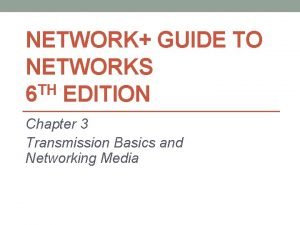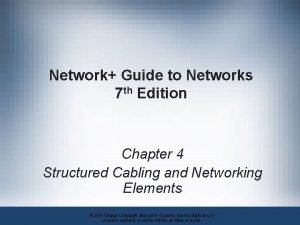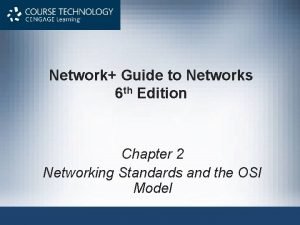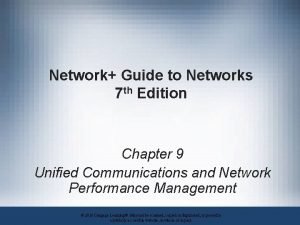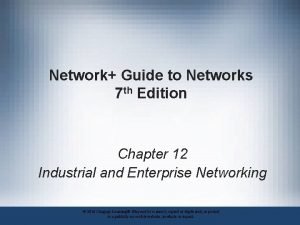Network Guide to Networks 7 th Edition Chapter





















































- Slides: 53

Network+ Guide to Networks 7 th Edition Chapter 2 How Computers Find Each Other on Networks © 2016 Cengage Learning®. May not be scanned, copied or duplicated, or posted to a publicly accessible website, in whole or in part.

Objectives • Describe how computers and other devices are addressed on a network • Explain how host names and domain names work • Identify how ports and sockets work at the OSI Transport layer • Demonstrate how IP addresses are assigned and formatted at the OSI Network layer • Use command-line tools to troubleshoot problems with network addresses Network+ Guide to Networks, 7 th Edition © Cengage Learning 2016 2

An Overview of Addressing on Networks • Four addressing methods: – Application layer FQDNs, computer names, and host names – Transport layer port numbers – Network layer IP address • IPv 4 addresses have 32 bits and are written as four decimal numbers called octets • IPv 6 addresses have 128 bits and are written as eight blocks of hexadecimal numbers – Data Link layer MAC address • Also called physical address Network+ Guide to Networks, 7 th Edition © Cengage Learning 2016 3

MAC Addresses • Traditional MAC addresses contain two parts – First 24 bits are known as the OUI (Organizationally Unique Identifier) or block ID or company-ID • Assigned by the IEEE – Last 24 bits make up the extension identifier or device ID • Manufacturer’s assign each NIC a unique device ID Network+ Guide to Networks, 7 th Edition © Cengage Learning 2016 4

MAC Addresses Network+ Guide to Networks, 7 th Edition © Cengage Learning 2016 5

How Host Names and Domain Names Work • Character-based names are easier to remember than numeric IP addresses • Last part of an FQDN is called the top-level domain (TLD) • Domain names must be registered with an Internet naming authority that works on behalf of ICANN – ICANN restricts what type of hosts can be associated with. arpa, . mil, . int, . edu, and. gov • Name resolution is the process of discovering the IP address of a host when you know the FQDN Network+ Guide to Networks, 7 th Edition © Cengage Learning 2016 6

How Host Names and Domain Names Work Network+ Guide to Networks, 7 th Edition © Cengage Learning 2016 7

DNS (Domain Name System) • DNS is an Application layer client-server system of computers and databases made up of these elements: – namespace - the entire collection of computer names and their associated IP addresses stored in databases on DNS name servers around the globe – name servers - hold databases, which are organized in a hierarchical structure – resolvers - a DNS client that requests information from DNS name servers Network+ Guide to Networks, 7 th Edition © Cengage Learning 2016 8

How Name Servers Are Organized • DNS name servers are organized in a hierarchical structure • At the root level, 13 clusters of root server hold information used to locate top-level domain (TLD) servers • TLD servers hold information about authoritative servers – The authority on computer names and their IP address for computer in their domains Network+ Guide to Networks, 7 th Edition © Cengage Learning 2016 9

How Name Servers Are Organized Network+ Guide to Networks, 7 th Edition © Cengage Learning 2016 10

How Name Servers Are Organized Network+ Guide to Networks, 7 th Edition © Cengage Learning 2016 11

How Name Servers Are Organized • Ways the resolution process can get more complex: – Caching-only server - when it receives a request for information that is not stored in its DNS cache, it will first query the company’s authoritative name server – Name servers within a company might not have access to root servers – A TLD name server might be aware of an intermediate name server rather than the authoritative name server Network+ Guide to Networks, 7 th Edition © Cengage Learning 2016 12

Recursive and Iterative Queries • Two types of DNS requests: – Recursive - a query that demands a resolution or the answer “It can’t be found” – Iterative - a query where the local server issues queries to other servers • Other servers only provide information if they have it • Do not demand a resolution Network+ Guide to Networks, 7 th Edition © Cengage Learning 2016 13

DNS Zones and Zone Transfers • DNS follows a distributed database model – Data is distributed over thousands of server so that DNS will not fail if one or a handful of servers experience errors • DNS zone - the domains an organization is responsible for managing • Primary DNS server holds the authoritative DNS database for the organization • Zone transfer - the process where a secondary DNS server makes a request to the primary server for a database update Network+ Guide to Networks, 7 th Edition © Cengage Learning 2016 14

DNS Server Software • BIND (Berkeley Internet Name Domain) - most popular DNS server software – Open source - the term for software whose code is publicly available for use and modification • Microsoft DNS Server - built-in DNS service in the Windows Server OS • Split DNS design - Internal and external DNS queries are handled by different DNS servers – Also called a split-horizon DNS Network+ Guide to Networks, 7 th Edition © Cengage Learning 2016 15

DNS Server Software Network+ Guide to Networks, 7 th Edition © Cengage Learning 2016 16

How a Namespace Database is Organized • Several types of records, called resource records are kept in a DNS database: – A (Address) record - stores the name-to-address mapping for a host – AAAA (Address) record - holds the name-to-address mapping, the IP address is an IPv 6 type IP address – CNAME (Canonical Name) record - holds alternative names for a host – PTR (Pointer) record - used for reverse lookups – MX (Mail Exchanger) record - identifies a mail server and is used for email traffic Network+ Guide to Networks, 7 th Edition © Cengage Learning 2016 17

DDNS (Dynamic DNS) • DDNS - a protocol used along with monitoring software to monitor the IP addresses dynamically assigned to your home network by your ISP – Manages dynamic updates to its DNS records for domain names for home Web sites • Home routers sometimes provide the monitoring software embedded in the router firmware Network+ Guide to Networks, 7 th Edition © Cengage Learning 2016 18

How Ports and Sockets Work • Port numbers - ensure data is transmitted to the correct application • Socket - consists of host’s IP address and the port number of an application running on the host – Colon separates the two values – Example - 10. 43. 3. 87: 23 • Port numbers are divided into three types: – Well-known ports - 0 to 1023 – Registered ports - 1024 to 49151 – Dynamic and private ports - 49152 to 65535 Network+ Guide to Networks, 7 th Edition © Cengage Learning 2016 19

How Ports and Sockets Work Network+ Guide to Networks, 7 th Edition © Cengage Learning 2016 20

How IP Addresses Are Formatted and Assigned • Two types of IP addresses: – IPv 4 - a 32 -bit address – IPv 6 - a 128 -bit address Network+ Guide to Networks, 7 th Edition © Cengage Learning 2016 21

How IPv 4 Addresses Are Formatted and Assigned • IPv 4 addresses – 32 -bit address organized into four groups of 8 bits each (known as octets) – Each of the four octets can be any number from 0 to 255 – Some IP addresses are reserved Network+ Guide to Networks, 7 th Edition © Cengage Learning 2016 22

Classes of IP Addresses • IPv 4 addresses are divided into five classes: – Class A, Class B, Class C, Class D, and Class E • When class licenses were available from IANA: – – Class A license was for a single octet Class B license was for the first two octets Class C license was for the first three octets Class D and Class E addresses were not available for general use • Class D begin with 224 -239 and are used for multicasting and Class E begin with octets 240 -254 and are used for research Network+ Guide to Networks, 7 th Edition © Cengage Learning 2016 23

Classes of IP Addresses Network+ Guide to Networks, 7 th Edition © Cengage Learning 2016 24

Classes of IP Addresses Network+ Guide to Networks, 7 th Edition © Cengage Learning 2016 25

How a DHCP Server Assigns IP Addresses • Static IP addresses are assigned manually by the network administrator • Dynamic IP addresses are automatically assigned by a DHCP server • If a computer configured to use DHCP is unable to lease an IPv 4 address from the DHCP server – It uses an Automatic Private IP Addressing (APIPA) address in the address range 169. 254. 0. 1 through 169. 254. 255. 254 Network+ Guide to Networks, 7 th Edition © Cengage Learning 2016 26

Public and Private IP Addresses • Class A, B, and C licensed IP addresses are available for use on the Internet – Called public IP addresses • A company can use private IP addresses on its private networks • IEEE recommends the following IP addresses be used for private networks: – 10. 0 through 10. 255 – 172. 16. 0. 0 through 172. 31. 255 – 192. 168. 0. 0 through 192. 168. 255 Network+ Guide to Networks, 7 th Edition © Cengage Learning 2016 27

Address Translation, NAT, and PAT • Network Address Translation (NAT) - a technique designed to conserve public IP addresses needed by a network • Address translation - process where a gateway device substitutes the private IP addresses with its own public address – When these computers need access to other networks or Internet • Port Address Translation (PAT) - process of assigning a TCP port number to each ongoing session between a local host and Internet host Network+ Guide to Networks, 7 th Edition © Cengage Learning 2016 28

Address Translation, NAT, and PAT Network+ Guide to Networks, 7 th Edition © Cengage Learning 2016 29

Address Translation, NAT, and PAT • Two variations of NAT to be aware of: – SNAT (Static Network Address Translation) - the gateway assigns the same public IP address to a host each time it makes a request to access the Internet – DNAT (Dynamic Network Address Translation) - the gateway has a pool of public address that it is free to assign to a local host when it makes a request to access the Internet Network+ Guide to Networks, 7 th Edition © Cengage Learning 2016 30

How IPv 6 Addresses Are Formatted and Assigned • An IPv 6 address has 128 bits written as eight blocks of hexadecimal numbers separated by colons – Ex: 2001: 0000: 0 B 80: 0000: 00 D 3: 9 C 5 A: 00 CC – Each block is 16 bits – Leading zeros in a four-character hex block can be eliminated – If blocks contain all zeroes, they can be written as double colons (: : ), only one set of double colons is used in an IP address – Therefore, above example can be written: • 2001: 0000: B 80: : D 3: 9 C 5 A: CC Network+ Guide to Networks, 7 th Edition © Cengage Learning 2016 31

How IPv 6 Addresses Are Formatted and Assigned • IPv 6 terminology: – Link (sometimes called local link) - any LAN bounded by routers – An interface is a node’s attachment to a link – Tunneling - a method used by IPv 6 to transport IPv 6 packets through or over an IPv 4 network – Interface ID - the last 64 bits or four blocks of an IPv 6 address that identify the interface – Neighbors - two or more nodes on the same link Network+ Guide to Networks, 7 th Edition © Cengage Learning 2016 32

Types of IP Addresses • Unicast address - specifies a single node on a network – Global unicast address - can be routed on the Internet – Link local unicast address - can be used for communicating with nodes in the same link • Multicast address - packets are delivered to all nodes on a network • Anycast address - can identify multiple destinations, with packets delivered to the closest destination Network+ Guide to Networks, 7 th Edition © Cengage Learning 2016 33

Types of IP Addresses Network+ Guide to Networks, 7 th Edition © Cengage Learning 2016 34

Types of IP Addresses Network+ Guide to Networks, 7 th Edition © Cengage Learning 2016 35

Types of IP Addresses Network+ Guide to Networks, 7 th Edition © Cengage Learning 2016 36

IPv 6 Autoconfiguration • IPv 6 addressing is designed so that a computer can autoconfigure its own link local IP address – Similar to how IPv 4 uses an APIPA address • Step 1 - The computer creates its IPv 6 address – Uses FE 80: : /64 as the first 64 bits – Last 64 bits can be generated in two ways: • Randomly generated • Generated from the network adapter’s MAC address • Step 2 - The computer checks to make sure its IP address is unique on the network Network+ Guide to Networks, 7 th Edition © Cengage Learning 2016 37

IPv 6 Autoconfiguration • Step 3 - The computer asks if a router on the network can provide configuration information – If a router responds with DHCP information, the computer uses whatever information this might be • Such as the IP addresses of DNS server or the network prefix • If the network prefix is supplied, this will become the first 64 bits of its own IP address – Process is called prefix discovery Network+ Guide to Networks, 7 th Edition © Cengage Learning 2016 38

Tunneling • Dual stacked - term given when a network is configured to use both IPv 4 and IPv 6 protocols • If packets on this network must traverse other networks where dual stacking is not used, tunneling is used • Three tunneling protocols: – 6 to 4 – ISATAP (Intra-Site Automatic Tunnel Addressing) – Teredo Network+ Guide to Networks, 7 th Edition © Cengage Learning 2016 39

Tunneling Network+ Guide to Networks, 7 th Edition © Cengage Learning 2016 40

Tools for Troubleshooting IP Address Problems • Event Viewer - one of the first places to start looking for clues when something goes wrong Network+ Guide to Networks, 7 th Edition © Cengage Learning 2016 41

ping • ping (Packet Internet Groper) - used to verify that TCP/IP is installed, bound to the NIC, configured correctly, and communicating with the network • The ping utility sends out a signal called an echo request to another device (request for a response) – Other computer responds in the form of an echo reply • ICMP - protocol used by the echo request/reply to carry error messages and information about the network Network+ Guide to Networks, 7 th Edition © Cengage Learning 2016 42

ping Network+ Guide to Networks, 7 th Edition © Cengage Learning 2016 43

ping • IPv 6 networks use a version of ICMP called ICMPv 6 – ping 6 - on Linux computers running IPv 6, use ping 6 to verify whether an IPv 6 host is available – ping -6 - on Windows computers, use ping with the 6 switch to verify connectivity on IPv 6 networks • For the ping 6 and ping -6 commands to work over the Internet, you must have access to the IPv 6 Internet Network+ Guide to Networks, 7 th Edition © Cengage Learning 2016 44

ipconfig Network+ Guide to Networks, 7 th Edition © Cengage Learning 2016 45

ifconfig • ifconfig - utility to view and manage TCP/IP settings • If your Linux or UNIX system provides a GUI – Open a shell prompt, then type ifconfig Network+ Guide to Networks, 7 th Edition © Cengage Learning 2016 46

nslookup • nslookup (name space lookup) - allows you to query the DNS database from any computer on a network – To find the host name of a device by specifying its IP address, or vice versa – Useful for verifying a host is configured correctly or for troubleshooting DNS resolution problems • Reverse DNS lookup - to find the host name of a device whose IP address you know • Two modes: – Interactive - to test multiple DNS servers at one time – Noninteractive - test a single DNS server Network+ Guide to Networks, 7 th Edition © Cengage Learning 2016 47

nslookup Network+ Guide to Networks, 7 th Edition © Cengage Learning 2016 48

nslookup • You can change DNS servers from within interactive mode with the server subcommand specifying the IP address of the new DNS server • To exit nslookup’s interactive mode, enter exit Network+ Guide to Networks, 7 th Edition © Cengage Learning 2016 49

Summary • Hosts on a network are assigned host names • Applications are assigned one or more port numbers to communicate with other applications • IPv 4 addresses have 32 bits and are written as four decimal numbers called octets • IPv 6 addresses have 128 bits and are written as eight blocks of hexadecimal numbers • Every NIC is assigned a unique 48 -bit MAC address • Use the ipconfig command to view IP configuration information Network+ Guide to Networks, 7 th Edition © Cengage Learning 2016 50

Summary • A FQDN includes both a host name portion and a domain name portion • Name resolution is the process of matching an FQDN to its IP address • DNS is an automated name resolution service that operates at the Application layer • DNS data is spread throughout the globe in a distributed database model • An IP address and a port number written together is called a socket Network+ Guide to Networks, 7 th Edition © Cengage Learning 2016 51

Summary • Well-known ports range from 0 to 1023 and are assigned by IANA • You can define a range of available IP addresses in DHCP, or assign a static IP address as a DHCP reservation • NAT is used to allow devices that have private IP addresses access to the Internet • Tunneling protocols are used to allow IPv 6 packets to travel over or through an IPv 4 network • Three types of IPv 6 addresses are unicast, multicast, and anycast addresses Network+ Guide to Networks, 7 th Edition © Cengage Learning 2016 52

Summary • The ping utility uses ICMP to verify that TCP/IP is installed, bound to the NIC, configured correctly, and communicating with the network • ipconfig is useful for viewing and adjusting a Windows computer’s TCP/IP settings • On UNIX and Linux systems, the ifconfig utility is used to view and manage TCP/IP settings • The nslookup utility allows you to query the DNS database from any computer on the network Network+ Guide to Networks, 7 th Edition © Cengage Learning 2016 53
 Difference between virtual circuit and datagram network
Difference between virtual circuit and datagram network Backbone networks in computer networks
Backbone networks in computer networks Neural networks and learning machines 3rd edition
Neural networks and learning machines 3rd edition Using mis 10th edition
Using mis 10th edition Using mis (10th edition)
Using mis (10th edition) Florida real estate broker's guide
Florida real estate broker's guide Florida real estate broker's guide
Florida real estate broker's guide A pocket guide to public speaking 6th edition free
A pocket guide to public speaking 6th edition free Wpan security
Wpan security Guide to computer forensics and investigations 6th edition
Guide to computer forensics and investigations 6th edition Prehospital emergency care 11th edition
Prehospital emergency care 11th edition The no brokerage relationship notice must be disclosed
The no brokerage relationship notice must be disclosed Florida real estate broker's guide 6th edition
Florida real estate broker's guide 6th edition Cwna guide to wireless lans 3rd edition
Cwna guide to wireless lans 3rd edition Forensics
Forensics Florida real estate broker's guide
Florida real estate broker's guide A pocket guide to public speaking 6th edition
A pocket guide to public speaking 6th edition A pocket guide to public speaking 6th edition
A pocket guide to public speaking 6th edition Dk guide to public speaking 2nd edition
Dk guide to public speaking 2nd edition Florida real estate broker's guide 6th edition
Florida real estate broker's guide 6th edition Florida real estate broker's guide
Florida real estate broker's guide Florida real estate broker's guide
Florida real estate broker's guide Palo alto networks certified network security engineer
Palo alto networks certified network security engineer Principles of network applications in computer networks
Principles of network applications in computer networks Network motifs: simple building blocks of complex networks
Network motifs: simple building blocks of complex networks Network layer design issues
Network layer design issues Internet structure network of networks
Internet structure network of networks Internet structure network of networks
Internet structure network of networks Network layer design issues
Network layer design issues Network performance measurement in computer networks
Network performance measurement in computer networks Network performance measurement in computer networks
Network performance measurement in computer networks Router node
Router node William stallings network security essentials 5th edition
William stallings network security essentials 5th edition Cryptography and network security 6th edition
Cryptography and network security 6th edition Dragon medical tutorials
Dragon medical tutorials Cryptography and network security 6th edition pdf
Cryptography and network security 6th edition pdf Cryptography and network security 4th edition
Cryptography and network security 4th edition Cryptographic systems are generically classified by
Cryptographic systems are generically classified by Cryptography and network security 7th edition
Cryptography and network security 7th edition Guide to network security
Guide to network security Guide to network defense and countermeasures
Guide to network defense and countermeasures Guide to network defense and countermeasures
Guide to network defense and countermeasures Information rules a strategic guide to the network economy
Information rules a strategic guide to the network economy Operational auditing
Operational auditing Ark ping
Ark ping Security guide to network security fundamentals
Security guide to network security fundamentals Security guide to network security fundamentals
Security guide to network security fundamentals Network topologies
Network topologies Features of peer to peer network and client server network
Features of peer to peer network and client server network Network systems design using network processors
Network systems design using network processors Network centric computing
Network centric computing Disadvantages of circuit switching
Disadvantages of circuit switching Organizational behavior 18th edition chapter 1
Organizational behavior 18th edition chapter 1 Organic chemistry (3rd) edition chapter 1 problem 16s
Organic chemistry (3rd) edition chapter 1 problem 16s







